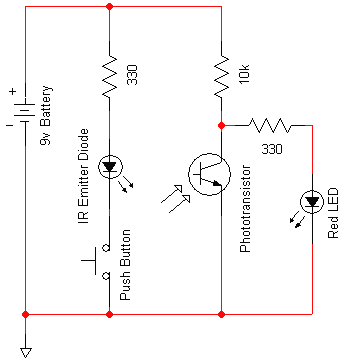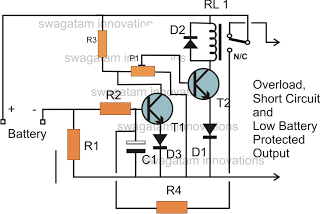
Sending Data Over IR Wireless Infrared Communication Link System

The fundamental theory behind infrared technology necessary for this tutorial was previously covered in the Infrared Receiver tutorial, so a concise overview will be provided here. The explanation will begin with a general description of infrared and its relevance in everyday life, followed by an exploration of how digital data can be transmitted through this wireless medium. The operation of the infrared transmitter and receiver pair is analogous to human vision; both systems respond to varying intensities of light. The phototransistor reacts similarly to the way human eyes perceive different colors, but unlike our brains, which interpret colors instinctively, the infrared LED and phototransistor require additional electronic components to process the transmitted data. For those uncertain about how binary data (0's and 1's) can be transmitted using an infrared emitter and phototransistor, constructing the circuit illustrated below will provide clarity. The circuit operates as follows: a 9V battery powers both the IR emitter and the phototransistor. The IR emitter remains off until the push button is pressed. When the emitter is inactive, the phototransistor does not conduct, allowing current to flow through a red LED, which stays illuminated until the button is pressed. Once the button is activated, the emitter illuminates the phototransistor, causing the red LED to turn off. A video demonstration of this circuit will provide a clearer visualization of how digital data is transmitted wirelessly through these infrared components. The illumination of the red LED represents a digital 1, while its absence indicates a 0. If a continuous stream of digital 1's and 0's is sent in place of the push button, the receiving phototransistor will detect the same sequence of data, enabling wireless transmission. The received digital data can then be fed into the receiving 18F452 microcontroller to complete the system.
The circuit described utilizes a basic infrared communication setup, consisting of an infrared LED (emitter), a phototransistor (receiver), a push button switch, a red LED for visual feedback, and a power source. The infrared LED is responsible for emitting infrared light when activated by the push button. The phototransistor detects this light and changes its state accordingly, allowing or blocking current flow to the red LED.
In practice, the 9V battery serves as the power supply for the entire circuit. The infrared LED is connected in series with the push button, ensuring that it only activates when the button is pressed. The phototransistor is connected in a manner that its output state can influence the red LED. When the infrared light is emitted, the phototransistor enters a conductive state, leading to the red LED turning off. Conversely, in the absence of infrared light, the phototransistor is non-conductive, allowing the red LED to illuminate.
This circuit exemplifies the fundamental principles of infrared communication by demonstrating how binary data can be represented through light signals. The transition between the states of the red LED serves as a visual indicator of the data being transmitted. In more advanced applications, additional circuitry can be integrated to enhance data processing, error correction, and signal modulation, allowing for more complex data transmission protocols. The incorporation of a microcontroller, such as the 18F452, enables further processing of the received data, facilitating its use in various applications, including remote controls, wireless sensors, and data communication systems.The core infrared theory for getting this tutorial working was already described in the Infrared Receiver tutorial, so I`ll run through an abridged version here. First I`ll describe as an overview what infrared is and how it relates to our lives, then I`ll go further to how we can transmit digital data over this wireless link.
The way that the inf rared transmitter and receiver pair works is similar to the way that our eyes work. We can see many different colors and depending on what we see, we act. The phototransistor functions in a similar way, it reacts depending upon the intensity of infrared light being shined at it. The real difference between the two similar cases above is that our brains already have a way to interpret the different wave lengths of color, where the infrared LED and phototransistor need some intelligent electronics in order to know what to do when certain data is transmitted.
If you`re still scratching your head in confusion as to how 0`s and 1`s can be transmitted using the IR emitter and phototransistor, then build the circuit seen below and it should help make things more clear: Here`s how the circuit above works: The 9v battery is hooked up to both the IR Emitter and Phototransistor. The IR Emitter, however, is never turned on unless you press the push button. Since the emitter is not powered on, the phototransistor won`t allow current to flow through it, so current will instead flow through the red LED.
This means until you press the push button, the red LED remains on. After you press the push button, the emitter shines brightly at the phototransistor and the red LED turns off. Here`s a video of this circuit in action: This should give you a much better visual of how digital 0`s and 1`s can be transmitted wirelessly using these two infrared components.
When the red LED shines, you can see a digital 1. When we press the push button and the red LED turns off, that would be a 0. Now if we replace a steady stream of digital 1`s and 0`s where the push button is the receiving phototransistor will see the same stream of digital 0`s and 1`s. Bingo! Wireless transmission. Feed the received stream of digital data into the receiving 18F452 microcontroller and the system is complete.
🔗 External reference
The circuit described utilizes a basic infrared communication setup, consisting of an infrared LED (emitter), a phototransistor (receiver), a push button switch, a red LED for visual feedback, and a power source. The infrared LED is responsible for emitting infrared light when activated by the push button. The phototransistor detects this light and changes its state accordingly, allowing or blocking current flow to the red LED.
In practice, the 9V battery serves as the power supply for the entire circuit. The infrared LED is connected in series with the push button, ensuring that it only activates when the button is pressed. The phototransistor is connected in a manner that its output state can influence the red LED. When the infrared light is emitted, the phototransistor enters a conductive state, leading to the red LED turning off. Conversely, in the absence of infrared light, the phototransistor is non-conductive, allowing the red LED to illuminate.
This circuit exemplifies the fundamental principles of infrared communication by demonstrating how binary data can be represented through light signals. The transition between the states of the red LED serves as a visual indicator of the data being transmitted. In more advanced applications, additional circuitry can be integrated to enhance data processing, error correction, and signal modulation, allowing for more complex data transmission protocols. The incorporation of a microcontroller, such as the 18F452, enables further processing of the received data, facilitating its use in various applications, including remote controls, wireless sensors, and data communication systems.The core infrared theory for getting this tutorial working was already described in the Infrared Receiver tutorial, so I`ll run through an abridged version here. First I`ll describe as an overview what infrared is and how it relates to our lives, then I`ll go further to how we can transmit digital data over this wireless link.
The way that the inf rared transmitter and receiver pair works is similar to the way that our eyes work. We can see many different colors and depending on what we see, we act. The phototransistor functions in a similar way, it reacts depending upon the intensity of infrared light being shined at it. The real difference between the two similar cases above is that our brains already have a way to interpret the different wave lengths of color, where the infrared LED and phototransistor need some intelligent electronics in order to know what to do when certain data is transmitted.
If you`re still scratching your head in confusion as to how 0`s and 1`s can be transmitted using the IR emitter and phototransistor, then build the circuit seen below and it should help make things more clear: Here`s how the circuit above works: The 9v battery is hooked up to both the IR Emitter and Phototransistor. The IR Emitter, however, is never turned on unless you press the push button. Since the emitter is not powered on, the phototransistor won`t allow current to flow through it, so current will instead flow through the red LED.
This means until you press the push button, the red LED remains on. After you press the push button, the emitter shines brightly at the phototransistor and the red LED turns off. Here`s a video of this circuit in action: This should give you a much better visual of how digital 0`s and 1`s can be transmitted wirelessly using these two infrared components.
When the red LED shines, you can see a digital 1. When we press the push button and the red LED turns off, that would be a 0. Now if we replace a steady stream of digital 1`s and 0`s where the push button is the receiving phototransistor will see the same stream of digital 0`s and 1`s. Bingo! Wireless transmission. Feed the received stream of digital data into the receiving 18F452 microcontroller and the system is complete.
🔗 External reference





